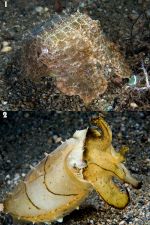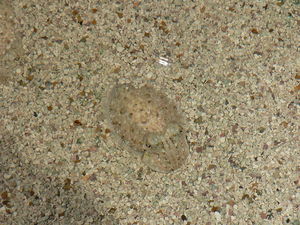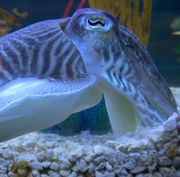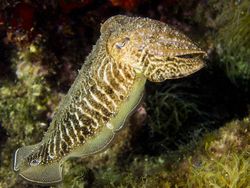Cuttlefish
| Cuttlefish | |
|---|---|
_dark_coloration.jpg) |
|
| Sepia latimanus, East Timor | |
| Scientific classification [ e ] | |
| Kingdom: | Animalia |
| Phylum: | Mollusca |
| Class: | Cephalopoda |
| Superorder: | Decapodiformes |
| Order: | Sepiida Zittel, 1895 |
| Suborders and Families | |
|
|
Cuttlefish are marine animals of the order Sepiida belonging to the class Cephalopoda (which also includes squid, octopuses, and nautiluses). Despite their common name, cuttlefish are not fish but molluscs. Recent studies indicate that cuttlefish are among the most intelligent invertebrates.[1] Additionally, it is noted that cuttlefish have one of the largest brain-to-body size ratios of all invertebrates.[1]
The origin of the word cuttlefish can be found in the old English term cudele, itself derived in the 1400s from the Norwegian koddi (cushion, testicle) and the Middle German kudel (pouch), a literal description of the cephalopod's shape. The Greco-Roman world valued the cephalopod as a source of the unique brown pigment released from its siphon when alarmed. Hence, the word for it in Greek and Latin, sepia (later seppia in Italian), has come to refer to a type of pigment in English.
Cuttlefish have an internal shell (the cuttlebone), large W-shaped pupils, and eight arms and two tentacles furnished with denticulated suckers, with which they secure their prey. They generally range in size from 15 cm (5.9 in) to 25 cm (9.8 in), with the largest species, Sepia apama, reaching 50 cm (20 in) in mantle length and over 10.5 kg (23 lb) in weight.[2]
Cuttlefish eat small molluscs, crabs, shrimp, fish, octopuses, worms, and other cuttlefish. Their predators include dolphins, sharks, fish, seals and other cuttlefish. Their life expectancy is about one to two years.
Contents |
Anatomy
Cuttlebone
Cuttlefish possess an internal structure called the cuttlebone, which is porous and composed of aragonite, to provide the cuttlefish with buoyancy. Buoyancy can be regulated by changing the gas-to-liquid ratio in the chambered cuttlebone via the ventral siphuncle.[3] Each species has a distinct shape, size, and pattern of ridges or texture on the cuttlebone. The cuttlebone is unique to cuttlefish, one of the features contrasting them with their squid relatives. Cuttlebones are traditionally used by jewelers and silversmiths as moulds for casting small objects.[4] They are probably better known today as the tough material given to parakeets and other caged birds as a source of dietary calcium.

Skin

Cuttlefish are sometimes referred to as the chameleon of the sea because of their remarkable ability to rapidly alter their skin color at will. Cuttlefish change color and light polarity to communicate to other cuttlefish and to camouflage themselves from predators.
This color-changing function is produced by groups of red, yellow, brown, and black pigmented chromatophores above a layer of reflective iridophores and leucophores, with up to 200 of these specialized pigment cells per square millimeter. The pigmented chromatophores have a sac of pigment and a large membrane that is folded when retracted. There are 6-20 small muscle cells on the sides which can contract to squash the elastic sac into a disc against the skin. Yellow chromatophores (xanthophores) are closest to the surface of the skin, red and orange are below (erythrophores), and brown or black are just above the iridophore layer (melanophores). The iridophores reflect blue and green light. Iridophores are plates of chitin or protein, which can reflect the environment around a cuttlefish. They are responsible for the metallic blues, greens, golds, and silvers often seen on cuttlefish. All of these cells can be used in combinations. For example, orange is produced by red and yellow chromatophores, while purple can be created by a red chromatophore and an iridophore. The cuttlefish can also use an iridophore and a yellow chromatophore to produce a brighter green. As well as being able to influence the color of light as it reflects off their skin, cuttlefish can also affect the light's polarization, which can be used to signal to other marine animals, many of which can also sense polarization.
Eyes

Cuttlefish eyes are among the most developed in the animal kingdom. The organogenesis of cephalopod eyes differs fundamentally from that of vertebrates like humans.[5] Superficial similarities between cephalopod and vertebrate eyes are thought to be examples of convergent evolution. The cuttlefish pupil is a smoothly-curving W shape. Although they cannot see color,[6] they can perceive the polarization of light, which enhances their perception of contrast. They have two spots of concentrated sensor cells on their retina (known as fovea), one to look more forward, and one to look more backwards. The lenses, instead of being reshaped as they are in humans, are pulled around by reshaping the entire eye to change focus.
Scientists have speculated that cuttlefish's eyes are fully developed before birth and start observing their surroundings while still in the egg. One team of French researchers has additionally suggested that cuttlefish prefer to hunt the prey they saw before hatching.[7]
Physiology
Circulation
The blood of a cuttlefish is an unusual shade of green-blue because it uses the copper-containing protein hemocyanin to carry oxygen instead of the red iron-containing protein haemoglobin that is found in mammals. The blood is pumped by three separate hearts, two of which pump blood to the cuttlefish's pair of gills (heart for each), and the third pumps blood around the rest of the body. Cuttlefish blood must flow more rapidly than most other animals because hemocyanin carries substantially less oxygen than haemoglobin.
Ink
Cuttlefish have ink, like squid and octopuses, which they use to help evade predators.
Ecology
Diet
The preferred diet of the cuttlefish is crabs and fish.[8]
The cuttlefish uses its camouflage to hunt and sneak up on its prey. When it gets close enough, it opens its eight arms and shoots out two long feeding tentacles. On the end of each is a pad covered in suckers that grabs and pulls prey toward its beak.[8]
Range and habitat
Family Sepiidae, which contains all cuttlefish, inhabit tropical/temperate ocean waters. They are mostly shallow-water animals although they are known to go to depths of about 600 metres (2,000 ft).[9] They have an unusual biogeographic pattern: totally absent from the Americas, but present along the coasts of east and south Asia, western Europe, the Mediterranean, as well as all coasts of Africa and Australia. By the time the family evolved, ostensibly in the Old World, the north Atlantic possibly had become too cold and deep for these warm water species to cross.[10]
Toxicity

The Pfeffer's Flamboyant Cuttlefish's muscles contain a highly toxic compound that is yet to be identified.[1] Mark Norman with Museum Victoria in Victoria, Australia, has shown the toxin to be as lethal as that of a fellow cephalopod, the blue-ringed octopus.[11]
Taxonomy

There are over 120 species of cuttlefish currently recognised, grouped into 5 genera. Sepiadariidae contains seven species and 2 genera; all the rest are in Sepiidae.
- CLASS CEPHALOPODA
- Subclass Nautiloidea: nautilus
- Subclass Coleoidea: squid, octopus, cuttlefish
- Superorder Octopodiformes
- Superorder Decapodiformes
- ?Order †Boletzkyida
- Order Spirulida: Ram's Horn Squid
- Order Sepiida: cuttlefish
- Suborder †Vasseuriina
- Family †Vasseuriidae
- Family †Belosepiellidae
- Suborder Sepiina
- Family †Belosaepiidae
- Family Sepiadariidae
- Family Sepiidae
- Suborder †Vasseuriina
- Order Sepiolida: bobtail squid
- Order Teuthida: squid
Relation to humans
Gastronomy
Cuttlefish are caught for food in the Mediterranean, East Asia, the English Channel and elsewhere. Although squid is more popular as a restaurant dish all over the world, in East Asia dried, shredded cuttlefish is a popular snack food.

Cuttlefish is especially popular in Italy, where it is used in Risotto al Nero di Seppia (literally black cuttlefish rice). The Croatian Crni Rižot is virtually the same recipe, which probably originated in Venice and then spread across both coasts of the Adriatic. "Nero" and "Crni" mean black, the color the rice turns because of the cuttlefish ink. Spanish cuisine, especially that of the coastal regions, uses cuttlefish and squid ink for the marine flavor and smoothness it provides; it is included in dishes such as rice, pasta and fish stews.
In Portugal, it is the regional dish of the city of Setúbal and surrounding areas, where it is served as deep-fried strips or in a variant of feijoada, with red kidney beans.
Cultural significance
Eugenio Montale's ground-breaking debut collection of poetry Cuttlefish Bones (Ossi di seppia) was published in Turin in 1925. Montale, who grew up in Liguria along the Mediterranean Sea, was awarded the Nobel Prize for Literature in 1975, for his long and prolific career. Cuttlefish Bones remains one of the best-known and influential collections of 20th-century Italian poetry.
Sepia
Cuttlefish ink was formerly an important dye, called sepia. Today artificial dyes have mostly replaced natural sepia. However, recently Jewish people have resumed using sepia for the techelet dye on their Tallit strings.
See also
References
- ↑ 1.0 1.1 1.2 NOVA, 2007. Cuttlefish: Kings of Camouflage. (television program) NOVA, PBS, April 3, 2007.
- ↑ Reid, A., P. Jereb, & C.F.E. Roper 2005. Family Sepiidae. In: P. Jereb & C.F.E. Roper, eds. Cephalopods of the world. An annotated and illustrated catalogue of species known to date. Volume 1. Chambered nautiluses and sepioids (Nautilidae, Sepiidae, Sepiolidae, Sepiadariidae, Idiosepiidae and Spirulidae). FAO Species Catalogue for Fishery Purposes. No. 4, Vol. 1. Rome, FAO. pp. 57–152.
- ↑ doi:10.1016/j.epsl.2006.04.025
This citation will be automatically completed in the next few minutes. You can jump the queue or expand by hand - ↑ Casting Silver with Cuttlefish
- ↑ Muller, Matthew. ""Development of the Eye in Vertebrates and Cephalopods and Its Implications for Retinal Structure"". The Cephalopod Eye. Davidson College Biology Department. http://www.bio.davidson.edu/people/midorcas/animalphysiology/websites/2003/Muller/development%20of%20the%20cephalopod%20eye.htm. Retrieved 2007-04-06.
- ↑ Mäthger, Lydia M.. ""Color blindness and contrast perception in cuttlefish (Sepia offcinalis) determined by a visual sensorimotor assay"". Vision Research, Volume 46, Issue 11, May 2006. Elsevier Ltd.. http://www.mbl.edu/mrc/hanlon/pdfs/mathger_et_al_visres_2006.pdf. Retrieved 2007-09-03.
- ↑ BBC News (2008-06-05). "Cuttlefish spot target prey early". http://news.bbc.co.uk/1/hi/sci/tech/7435757.stm. Retrieved 2008-05-06.
- ↑ 8.0 8.1 Cuttlefish Basics
- ↑ Lu, C. C. and C. F. E. Roper. 1991. Aspects of the biology of Sepia cultrata from southeastern Australia. In: La Seiche, The Cuttlefish. Boucaud-Camou, E. (Ed). Caen, France; Centre de Publications de l'Université de Caen: 192.
- ↑ Young, R. E., M. Vecchione and D. Donovan, 1998. The evolution of coleoid cephalopods and their present biodiversity and ecology. South African Jour. Mar. Sci., 20: 393-420.
- ↑ Teacher's Guide to NOVA episode - Kings of Camouflage on PBS (After Watching: Activity 2).
External links
- TONMO.com Community Forum - Keeping cuttlefish in the home aquarium
- Scientific Database with photos and videos of cuttlefish and other cephalopods
- YouTube video with examples of color and texture modulation.
- Youtube video Cuttlefish changing colour and shape
- Amazing cuttlefish - Cephalopods with natural camouflage and sepia ink
- PBS.org - Nova - Kings of Camouflage
|
|||||